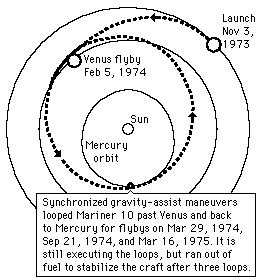Mariner Exploration Missions
The Mariner series of U.S. spacecraft explored the inner solar system, obtaining information about Mercury, Venus, and Mars. Mariner 2 was the first successful space probe and the first spacecraft to visit a planet. It passed Venus at about 34,758 km on December 14, 1962. Mariner 4 explored Mars at low resolution in 1965 and Mariners 6 & 7 got a higher resolution look in 1969. Mariner 9 mapped entire surface of Mars in 1971 and 1972, sending back 7329 closeup pictures. Mariner 9 arrived into martian orbit on November 13, 1971 in the midst of an enormous dust storm which completely obscured the surface for weeks. When the dust cleared it found such remarkable features as a 24km (15 mile) high volcano named Olympus Mons, three times as high as Mt. Everest. Mariner 10 mapped surface of Mercury in 1974 as a part of a fortuitous slingshot orbit with Venus.

Solar System Illustration
Solar System Concepts
